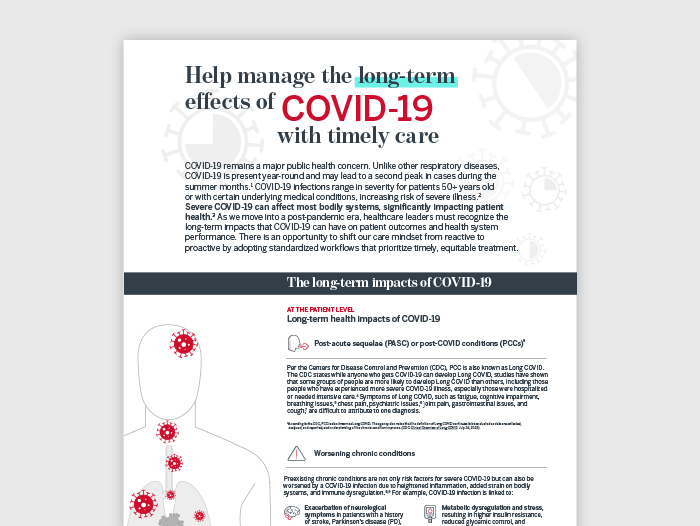Auto logout in seconds.
Continue LogoutIn March 2020, the World Health Organization declared COVID-19 a global pandemic. Here's what we've learned about the virus since then, what we still don't know, and its ongoing impact on both people's health and society at large.
What we've learned about COVID-19 since the pandemic
According to the New York Times, "nearly everything about [COVID-19] was an open question" during the early days of the pandemic. Since then, scientists have managed to unravel some of the biggest mysteries surrounding the virus, but other questions remain.
How does COVID-19 spread?
At the start of the pandemic, many people were concerned that COVID-19 could spread through contaminated surfaces. However, research suggests that it is more likely to spread through the air, either through large droplets produced when a person coughs or sneezes or by smaller particles called aerosols.
"These particles kind of behave like cigarette smoke — they come out and float around, and they can drift in the air for a while," said Linsey Marr, an environmental engineer at Virginia Tech. Marr and other researchers have found that aerosols as small as five microns may carry more infectious viral particles than larger droplets.
Other studies have found that the virus is still evolving and could spread more effectively through the air over time.
What are common (and uncommon) COVID-19 symptoms?
Most people who have been infected by COVID-19 experienced flu-like symptoms, but some people experienced no symptoms at all. Other people, particularly those who were older or had existing health problems, experienced more severe symptoms and may have been hospitalized.
Some of the more unusual COVID-19 symptoms that people experienced, such as a loss of smell, may have been due to a dysfunctional immune response. For example, researchers found that the virus attached to the ACE2 receptor in the nose among people who lost their sense of smell. The immune response to the virus can inadvertently change the genetic activity of certain nerves in the nose, which then disrupts the sense of smell.
In addition, Maria Elena Ruiz, an infectious disease specialist at George Washington University, said that this aggressive immune response and subsequent inflammation may also be critical to understanding other lingering neurological effects of COVID-19, including brain fog, headaches, tingling or numbness, and more.
How long does immunity against COVID-19 last?
According to Akiko Iwasaki, a virologist and immunologist at Yale University, a COVID-19 infection or vaccination should protect you from the virus for several months. However, your immunity can also be impacted by many different factors, including age, underlying health, and whether the virus has picked up mutations that make it more evasive.
Generally, health experts believe that higher antibody levels are correlated with better protection, but some studies suggest that antibody levels drop significantly three months after an infection or a vaccination. It's also not clear how many antibodies are necessary for baseline protection since "new variants are continuously arising," Iwasaki said.
Another type of immune protection from T cells can reduce the severity of COVID-19 symptoms rather than block infection completely. Currently, research suggests T cell immunity against COVID-19 may last a year or more.
Will COVID-19 ever become seasonal like the flu?
After the first winter COVID-19 surge, many people hoped that the virus would spread less readily during the warmer summer months. Compared to summer, there is generally more opportunity for viral spread in the winter since more people are indoors and there is less ventilation in buildings.
However, health experts say that COVID-19 does not seem to be inherently seasonal. "[W]e've clearly had surges in the summer as well," Marr said.
Separately, Vincent Munster, chief of the virus ecology section at the National Institute of Allergy and Infectious Diseases' Rocky Mountain Laboratories, said that while he would not be surprised if COVID-19 eventually settle into a predictable seasonal pattern, it's difficult to predict if that will occur in the next few years or take decades.
The ongoing impact of COVID-19
Although COVID-19 is no longer as prevalent as it used to be during the early days of the pandemic, it still has a significant impact on many people.
Currently, CDC data shows that there were 15,141 COVID-19 hospitalizations for the week ending March 2. There are also around 500 to 1,500 COVID-19 deaths every week — much lower than in the past but still higher than mortality from the flu.
There are also many people with long COVID, or persistent symptoms after their initial infections. According to a CDC study, 6% of U.S. adults reported having long COVID in June 2023, and 26.4% of these individuals reported "significant activity limitations" due to their symptoms.
The COVID-19 pandemic also led to a significant number of excess deaths, or the number of deaths above what was expected from pre-pandemic trends, worldwide. According to The Economist, there have been roughly 30 million excess deaths in the four years since COVID-19 first emerged.
These excess deaths include deaths from COVID-19, deaths from undiagnosed cases, and deaths from pandemic disruptions, such as missed doctor appointments, that could have prevented other diseases. The isolation of the pandemic may have also led to an increased number of deaths from alcohol, drugs, vehicle crashes, and more.
There have also been indirect effects of COVID-19, including learning loss among young students. Although some states are beginning to see improvements from pandemic-era proficiency scores, others are still lagging behind. So far, Minnesota, Missouri, Massachusetts, and Nevada have all seen continued declines in their statewide English language arts proficiency rates.
"Four years ago, our world changed," the New York Times writes. "As a society, we are not close to fully recovered." (Leonhardt, New York Times, 3/11; Lamas, New York Times, 3/10; Sheikh, New York Times, 3/11; CDC COVID Data Tracker, accessed 3/11)
Health systems across the world have had no shortage of challenges and hurdles to overcome in the last four years. Many organizations viewed these challenges as an opportunity to make meaningful progress or adapt their strategic priorities. Download our playbook to help you plan your post-COVID-19 strategy.
Don't miss out on the latest Advisory Board insights
Create your free account to access 1 resource, including the latest research and webinars.
Want access without creating an account?
You have 1 free members-only resource remaining this month.
1 free members-only resources remaining
1 free members-only resources remaining
You've reached your limit of free insights
Become a member to access all of Advisory Board's resources, events, and experts
Never miss out on the latest innovative health care content tailored to you.
Benefits include:
You've reached your limit of free insights
Become a member to access all of Advisory Board's resources, events, and experts
Never miss out on the latest innovative health care content tailored to you.
Benefits include:
This content is available through your Curated Research partnership with Advisory Board. Click on ‘view this resource’ to read the full piece
Email ask@advisory.com to learn more
Click on ‘Become a Member’ to learn about the benefits of a Full-Access partnership with Advisory Board
Never miss out on the latest innovative health care content tailored to you.
Benefits Include:
This is for members only. Learn more.
Click on ‘Become a Member’ to learn about the benefits of a Full-Access partnership with Advisory Board
Never miss out on the latest innovative health care content tailored to you.


